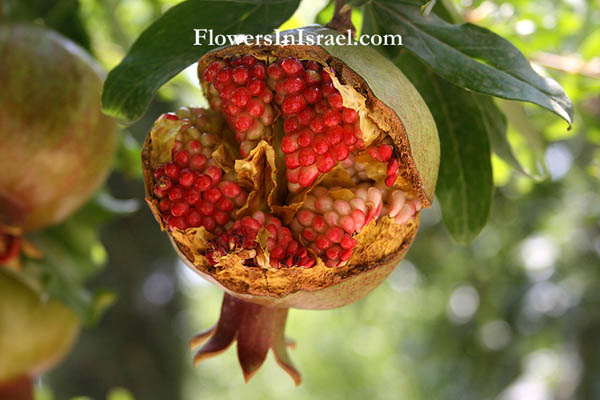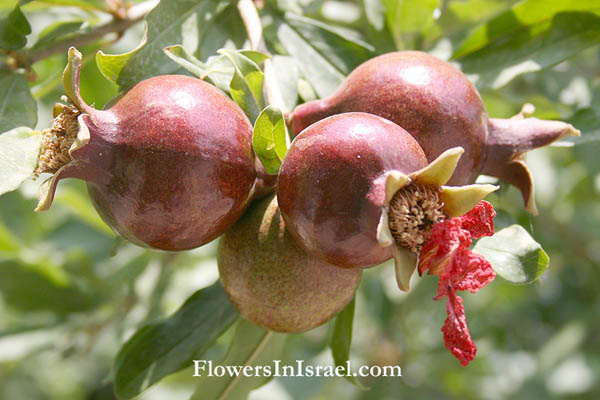
Location: Beit Shean, parking National Park
Derivation of the botanical name:
punica, Latin punicus, scarlet or red but also referring to the so-called
Punic Wars. The Romans called it the Punic apple because it came from Carthage.
granatum, from granum, "grain" and means "(multi)grained" (alluding to the many seed grains).
pomegranate derives from Latin pomum, ("apple") and granatus, ("grains").
The Hebrew word rimmôn, and Arabic rummân derived from the ancient Egyptiam rmn. In Hebrew the word rimon (רימון) may mean both "pomegranate fruit" and "shell".
In many European languages, the weapon shell has names similar to granate. These derive from the same Latin word granum “grain”, attested in 1532, from the French name for the fruit (pome) grenade.
"Granada" is the Spanish word for "pomegranate." And Grenada is an island country lying in close proximity to the Grenadine islands and in the list of exports does not include pomegranates - in fact, pomegranates do not fair their best in tropical climates.
Grenadine (grenadine syrup) is a syrup made from pomegranates.
- The standard author abbreviation L. is used to indicate Carl Linnaeus (1707 – 1778), a Swedish botanist, physician, and zoologist, the father of modern taxonomy.
The pomegranate is frequently referred to in Semitic literatures, is often represented on Assyrian and Egyptian monuments, and was a religious symbol in many ancient cults. It has a place in Jewish, Christian, Buddhist, Islamic and Pagan traditions alike.
It was one of the common fruit-trees in Israel (Deut. 8:8; Joel 1:12, etc.).
Some scholars of antiquity assume that the pomegranate was the tree of life in the Garden of Eden, and according to a number of legends it was the fruit of this tree rather than the apple with which Eve tempted Adam. The two fruits are alike, at least on the outside.
In a Homeric Hymn, Persephone, daughter of Ceres, the Goddess of growth and abundance, was forced to spend four months of each year in the underworld, because Pluto forced her to eat the seed of the pomegranate, when she was held captive in the underworld. The period of time in which this would take place is during winter, with spring heralding the return to the world aboveground.
Because of its role in the Greek legend of Persephone, the pomegranate came to symbolize fertility, death, and eternity and was an emblem of the Eleusinian Mysteries.
Pausanias (143-176AD) wrote in 'Description of Greece' [2.17.4]: The statue of Hera is seated on a throne; it is huge, made of gold and ivory, and is a work of Polycleitus. She is wearing a crown with Graces and Seasons worked upon it, and in one hand she carries a pomegranate and in the other a sceptre. About the pomegranate I must say nothing, for its story is somewhat of a holy mystery.'
The pomegranate has sometimes been taken as a symbol of fertility, appropiate to the godess who presided over marriage.
Karl Bötticher (1806–89), a German archaeologist, interpreted it differently [Archaologische Zeitung, 1856, pp. 169.176]. He pointed out that, from the blood-red appearance of the inside of the fruit, it was associated with ideas of blood and death. It was said to have sprung from the blood of Dionysus.
In Greek mythology the Furies / Erinyes planted a pomegranate tree on the grave of the slain Eteocles (king of Thebes, the son of Oedipus); when the fruit was pulled, blood flowed from it.
A pomegranate tree grew over the grave of the suicide Meneceus (Pausanias 9.25.1 : On the tomb of Menoeceus grows a pomegranate-tree. If you break through the outer part of the ripe fruit, you will then find the inside like blood. This pomegranate-tree is still flourishing).
To dream of pomegranates foreshadowed wounds (Artemidorus, Onirocr. i. 73).
Proserpine, after she had been carried off by Pluto to the lower world, would have been allowed to returnm to the upper world if she had not eaten a seed of a pomegranate.
In Christianity the Pomegranate is the symbol of the Resurrection of Jesus after its classical association with Persephone (Persephone is the equivalent of the Roman goddess Proserpine, an ancient Roman goddess), a life-death-rebirth deity.
The many seeds contained in its tough case made it also a symbol of the unity of the many under one authority, and of chastity.
Jewish tradition teaches that the pomegranate is a symbol for righteousness, because it is said to have 613 seeds which corresponds with the 613 mitzvot or commandments of the Torah. For this reason and others many Jews eat pomegranates on Rosh Hashanah.
Of the seven species in Deut. 8:8, Punica granatum L. (Punicaceae) may be the most beautiful.
Pomegranates figure prominently in three places in Scripture: the garment of the high priest (Exod. 28:33), as a garland on the temple pillars, and in the Song of Songs.
Solomon's temple had four hundred pomegranates engraved on the capitals of the two pillars located at the front of the temple (1 Kings 7:42; 2 Chron. 4:13). These pomegranates are also mentioned in Jer. 52:22–23.
In Song of Songs 4:3 and 6:7, the red interior of the fruit is likened to the temples of the Beloved.
"The network with pomegranates" of the temple of Salomon (I Kings 7:41-2) and the pomegranate on the garments of Aaron (Exodus 28:33-4) were no doubt symbolical.
The classical authors mentioned wine made from pomegranate juice, which was according to Dioscorides (ca. 40-ca. 90 CE) used for medicinal purposes and he recorded it as 'to bind the stomach'. Pomegranate may be used in the treatment of dysentry, diarrhoea and stomach-ache. The rind was used to dye the leather yellow (Pliny, N.H.XIII.XXXIV).
Bible resources:
- Exodus 28:33
Make pomegranates of blue, purple and scarlet yarn around the hem of the robe, with gold bells between them.
- Exodus 28:34
The gold bells and the pomegranates are to alternate around the hem of the robe.
- Exodus 39:24
They made pomegranates of blue, purple and scarlet yarn and finely twisted linen around the hem of the robe.
- Exodus 39:25
And they made bells of pure gold and attached them around the hem between the pomegranates.
- Exodus 39:26
The bells and pomegranates alternated around the hem of the robe to be worn for ministering, as the LORD commanded Moses.
- Numbers 13:23
When they reached the Valley of Eshkol, they cut off a branch bearing a single cluster of grapes. Two of them carried it on a pole between them, along with some pomegranates and figs.
- Numbers 20:5
Why did you bring us up out of Egypt to this terrible place? It has no grain or figs, grapevines or pomegranates. And there is no water to drink!”
- Deuteronomy 8:8
a land with wheat and barley, vines and fig trees, pomegranates, olive oil and honey;
- 1 Samuel 14:2
Saul was staying on the outskirts of Gibeah under a pomegranate tree in Migron. With him were about six hundred men,
- 1 Kings 7:18
He made pomegranates in two rows encircling each network to decorate the capitals on top of the pillars. He did the same for each capital.
- 1 Kings 7:20
On the capitals of both pillars, above the bowl-shaped part next to the network, were the two hundred pomegranates in rows all around.
- 1 Kings 7:42
the four hundred pomegranates for the two sets of network (two rows of pomegranates for each network decorating the bowl-shaped capitals on top of the pillars);
- 2 Kings 25:17
Each pillar was eighteen cubits high. The bronze capital on top of one pillar was three cubits high and was decorated with a network and pomegranates of bronze all around. The other pillar, with its network, was similar.
- 2 Chronicles 3:16
He made interwoven chains and put them on top of the pillars. He also made a hundred pomegranates and attached them to the chains.
- 2 Chronicles 4:13
the four hundred pomegranates for the two sets of network (two rows of pomegranates for each network, decorating the bowl-shaped capitals on top of the pillars);
- Song of Solomon 4:3
Your lips are like a scarlet ribbon; your mouth is lovely. Your temples behind your veil are like the halves of a pomegranate.
- Song of Solomon 4:13
Your plants are an orchard of pomegranates with choice fruits, with henna and nard,
- Song of Solomon 6:7
Your temples behind your veil are like the halves of a pomegranate.
- Song of Solomon 6:11
He I went down to the grove of nut trees to look at the new growth in the valley, to see if the vines had budded or the pomegranates were in bloom.
- Song of Solomon 7:12
Let us go early to the vineyards to see if the vines have budded, if their blossoms have opened, and if the pomegranates are in bloom— there I will give you my love.
- Song of Solomon 8:2
I would lead you and bring you to my mother’s house— she who has taught me. I would give you spiced wine to drink, the nectar of my pomegranates.
- Jeremiah 52:22
The bronze capital on top of one pillar was five cubits high and was decorated with a network and pomegranates of bronze all around. The other pillar, with its pomegranates, was similar.
- Jeremiah 52:23
There were ninety-six pomegranates on the sides; the total number of pomegranates above the surrounding network was a hundred.
- Joel 1:12
The vine is dried up and the fig tree is withered; the pomegranate, the palm and the apple tree— all the trees of the field—are dried up. Surely the people’s joy is withered away.
- Haggai 2:19
Is there yet any seed left in the barn? Until now, the vine and the fig tree, the pomegranate and the olive tree have not borne fruit. “‘From this day on I will bless you.’”
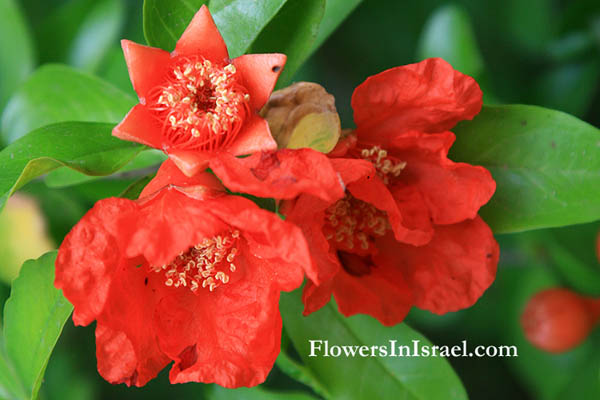
Location: Golan,Banias, parking National Park
Try: Fesenjan - Duck with Pomegranate & Walnut Sauce
This duck recipe is adapted from one featured in:
Claudia Roden's The Book of Jewish Food.
2 tablespoons sunflower oil
4 duck breasts, skinned and scored
1 large onion, thinly sliced
2 cloves garlic, thinly sliced
salt and freshly ground black pepper
3 tablespoons pomegranate molasses
150mls chicken stock
75g walnuts, finely chopped
2-3 teaspoons sugar, or to taste
Gently fry the duck breasts in oil, skin side down for 5-10 minutes, until they release their fat. Add the onion, garlic and salt and pepper. Fry until onion is soft, stirring occasionally. Once the skin has browned, turn the heat up and brown the flesh side. Remove the duck from the pan and leave in a warm place.
Pour the duck fat from the onions and reserve fat for another use. Add the pomegranate molasses, chicken stock, walnuts and a little sugar to taste. Stir well, bring to a simmer then return the duck to the pan. Continue cooking until the duck is medium rare. Rest the duck for 5 minutes while you reduce the liquid to sauce consistency.
Serves 4.
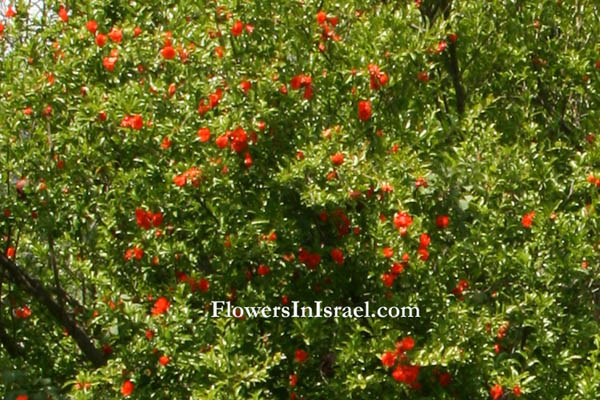
Location: Golan,Banias, parking National Park
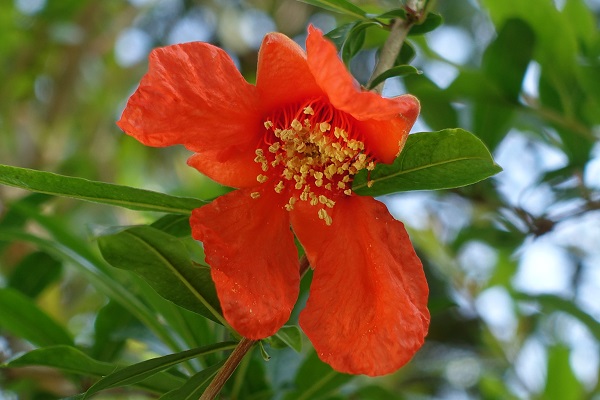
|
